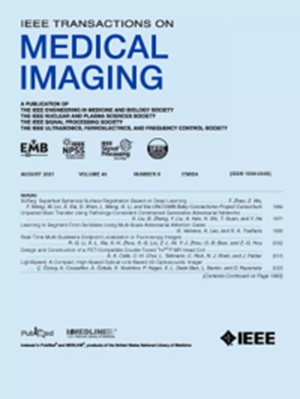Collaborative Learning of Augmentation and Disentanglement for Semi-Supervised Domain Generalized Medical Image Segmentation.
IF 9.8
1区 医学
Q1 COMPUTER SCIENCE, INTERDISCIPLINARY APPLICATIONS
引用次数: 0
Abstract
This paper explores a challenging yet realistic scenario: semi-supervised domain generalization (SSDG) that includes label scarcity and domain shift problems. We pinpoint that the limitations of previous SSDG methods lie in 1) neglecting the difference between domain shifts existing within a training dataset (intra-domain shift, IDS) and those occurring between training and testing datasets (cross-domain shift, CDS) and 2) overlooking the interplay between label scarcity and domain shifts, resulting in these methods merely stitching together semi-supervised learning (SSL) and domain generalization (DG) techniques. Considering these limitations, we propose a novel perspective to decompose SSDG into the combination of unsupervised domain adaptation (UDA) and DG problems. To this end, we design a causal augmentation and disentanglement framework (CausalAD) for semi-supervised domain generalized medical image segmentation. Concretely, CausalAD involves two collaborative processes: an augmentation process, which utilizes disentangled style factors to perform style augmentation for UDA, and a disentanglement process, which decouples domain-invariant (content) and domain-variant (noise and style) features for DG. Furthermore, we propose a proxy-based self-paced training strategy (ProSPT) to guide the training of CausalAD by gradually selecting unlabeled image pixels with high-quality pseudo labels in a self-paced training manner. Finally, we introduce a hierarchical structural causal model (HSCM) to explain the intuition and concept behind our method. Extensive experiments in the cross-sequence, cross-site, and cross-modality semi-supervised domain generalized medical image segmentation settings show the effectiveness of CausalAD and its superiority over the state-of-the-art. The code is available at https://github.com/Senyh/CausalAD.半监督域广义医学图像分割的增强解纠缠协同学习。
本文探讨了一个具有挑战性但现实的场景:半监督域泛化(SSDG),其中包括标签稀缺性和域移位问题。我们指出,以前的SSDG方法的局限性在于:1)忽视了训练数据集中存在的领域转移(域内转移,IDS)与训练和测试数据集中发生的领域转移(跨领域转移,CDS)之间的差异;2)忽视了标签稀缺和领域转移之间的相互作用,导致这些方法仅仅将半监督学习(SSL)和领域泛化(DG)技术结合在一起。考虑到这些局限性,我们提出了一种新的视角,将SSDG分解为无监督域自适应(UDA)和DG问题的组合。为此,我们设计了一个用于半监督域广义医学图像分割的因果增强和解纠缠框架(CausalAD)。具体来说,CausalAD涉及两个协作过程:一个是增强过程,它利用解纠缠的风格因素对UDA进行风格增强,另一个是解纠缠过程,它将DG的域不变(内容)和域变(噪声和风格)特征解耦。此外,我们提出了一种基于代理的自节奏训练策略(prospect),通过自节奏训练的方式逐步选择具有高质量伪标签的未标记图像像素来指导CausalAD的训练。最后,我们引入了一个层次结构因果模型(HSCM)来解释我们方法背后的直觉和概念。在跨序列、跨站点和跨模态半监督域广义医学图像分割设置中进行的大量实验表明,CausalAD的有效性及其优于最先进的技术。代码可在https://github.com/Senyh/CausalAD上获得。
本文章由计算机程序翻译,如有差异,请以英文原文为准。
求助全文
约1分钟内获得全文
求助全文
来源期刊

IEEE Transactions on Medical Imaging
医学-成像科学与照相技术
CiteScore
21.80
自引率
5.70%
发文量
637
审稿时长
5.6 months
期刊介绍:
The IEEE Transactions on Medical Imaging (T-MI) is a journal that welcomes the submission of manuscripts focusing on various aspects of medical imaging. The journal encourages the exploration of body structure, morphology, and function through different imaging techniques, including ultrasound, X-rays, magnetic resonance, radionuclides, microwaves, and optical methods. It also promotes contributions related to cell and molecular imaging, as well as all forms of microscopy.
T-MI publishes original research papers that cover a wide range of topics, including but not limited to novel acquisition techniques, medical image processing and analysis, visualization and performance, pattern recognition, machine learning, and other related methods. The journal particularly encourages highly technical studies that offer new perspectives. By emphasizing the unification of medicine, biology, and imaging, T-MI seeks to bridge the gap between instrumentation, hardware, software, mathematics, physics, biology, and medicine by introducing new analysis methods.
While the journal welcomes strong application papers that describe novel methods, it directs papers that focus solely on important applications using medically adopted or well-established methods without significant innovation in methodology to other journals. T-MI is indexed in Pubmed® and Medline®, which are products of the United States National Library of Medicine.
 求助内容:
求助内容: 应助结果提醒方式:
应助结果提醒方式:


